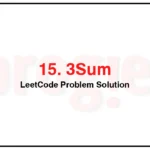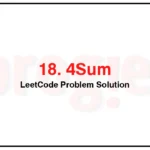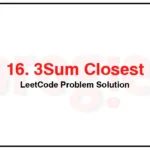27. Remove Element LeetCode Solution
In this guide we will provide 27. Remove Element LeetCode Solution with best time and space complexity. The solution to Remove Element problem is provided in various programming languages like C++, Java and python. This will be helpful for you if you are preparing for placements, hackathon, interviews or practice purposes. The solutions provided here are very easy to follow and with detailed explanations.
Table of Contents
- Problem Statement
- Remove Element solution in C++
- Remove Element soution in Java
- Remove Element solution Python
- Additional Resources

Problem Statement of Remove Element
Given an integer array nums and an integer val, remove all occurrences of val in nums in-place. The order of the elements may be changed. Then return the number of elements in nums which are not equal to val.
Consider the number of elements in nums which are not equal to val be k, to get accepted, you need to do the following things:
Change the array nums such that the first k elements of nums contain the elements which are not equal to val. The remaining elements of nums are not important as well as the size of nums.
Return k.
Custom Judge:
The judge will test your solution with the following code:
int[] nums = […]; // Input array
int val = …; // Value to remove
int[] expectedNums = […]; // The expected answer with correct length.
// It is sorted with no values equaling val.
int k = removeElement(nums, val); // Calls your implementation
assert k == expectedNums.length;
sort(nums, 0, k); // Sort the first k elements of nums
for (int i = 0; i < actualLength; i++) {
assert nums[i] == expectedNums[i];
}
If all assertions pass, then your solution will be accepted.
Example 1:
Input: nums = [3,2,2,3], val = 3
Output: 2, nums = [2,2,_,_]
Explanation: Your function should return k = 2, with the first two elements of nums being 2.
It does not matter what you leave beyond the returned k (hence they are underscores).
Example 2:
Input: nums = [0,1,2,2,3,0,4,2], val = 2
Output: 5, nums = [0,1,4,0,3,_,_,_]
Explanation: Your function should return k = 5, with the first five elements of nums containing 0, 0, 1, 3, and 4.
Note that the five elements can be returned in any order.
It does not matter what you leave beyond the returned k (hence they are underscores).
Constraints:
0 <= nums.length <= 100
0 <= nums[i] <= 50
0 <= val <= 100
Complexity Analysis
- Time Complexity: O(n)
- Space Complexity: O(1)
27. Remove Element LeetCode Solution in C++
class Solution {
public:
int removeElement(vector<int>& nums, int val) {
int i = 0;
for (const int num : nums)
if (num != val)
nums[i++] = num;
return i;
}
};
/* code provided by PROGIEZ */27. Remove Element LeetCode Solution in Java
class Solution {
public int removeElement(int[] nums, int val) {
int i = 0;
for (final int num : nums)
if (num != val)
nums[i++] = num;
return i;
}
}
// code provided by PROGIEZ27. Remove Element LeetCode Solution in Python
class Solution:
def removeElement(self, nums: list[int], val: int) -> int:
i = 0
for num in nums:
if num != val:
nums[i] = num
i += 1
return i
#code by PROGIEZAdditional Resources
- Explore all Leetcode problems solutions at Progiez here
- Explore all problems on Leetcode website here
Feel free to give suggestions! Contact Us









